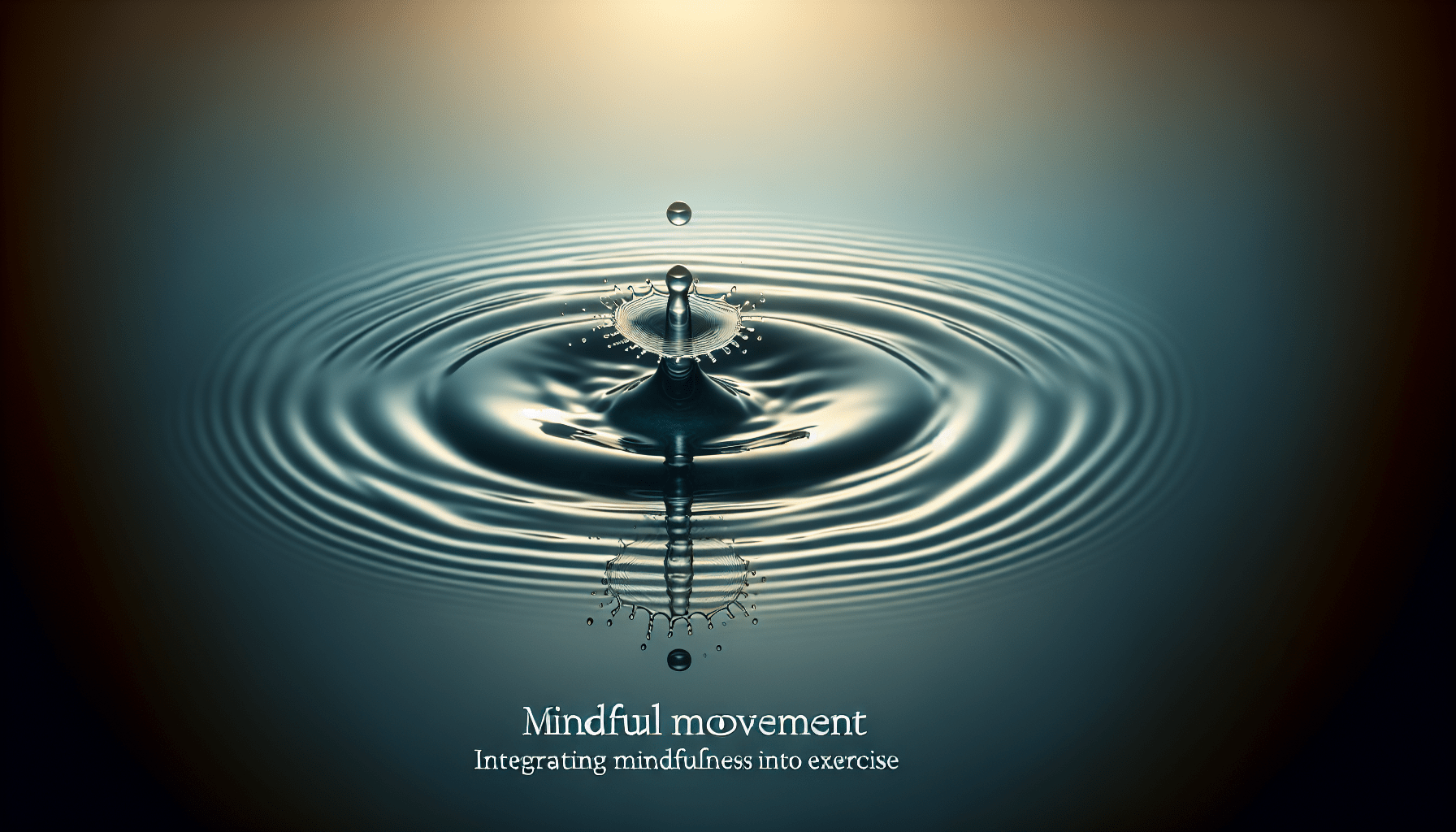
Mindful Movement: Integrating Mindfulness Into Exercise

Incorporating mindfulness into exercise can enhance both the physical and mental benefits of your workout routine. By practicing mindfulness techniques such as staying present and maintaining concentration, you can eliminate distractions and fully engage with your body during exercise. This article will explore the concept of mindful movement and provide resources to help you integrate mindfulness into your exercise routine. Whether you’re a beginner or a seasoned athlete, cultivating a mindful approach to your workouts can lead to a more rewarding and fulfilling fitness journey.
1. Understanding Mindfulness
Definition of mindfulness
Mindfulness is the practice of intentionally bringing our attention to the present moment without judgment. It involves being fully aware of our thoughts, feelings, bodily sensations, and the environment around us. The goal is to cultivate a state of heightened awareness and focus, allowing us to fully experience and appreciate each moment as it unfolds.
Benefits of mindfulness
There are numerous benefits to practicing mindfulness, particularly when it comes to exercise. Mindfulness can help reduce stress and anxiety, improve concentration and focus, enhance self-awareness, and promote overall mental well-being. It can also improve physical performance and efficiency in exercise by helping to optimize movement, prevent injuries, and increase body awareness. By bringing an intentional and non-judgmental attitude to our exercise routines, mindfulness allows us to fully engage with our bodies and cultivate a deeper sense of connection and appreciation for the physical sensations and movements involved.
2. Mindfulness and Exercise: A Perfect Combination
Overview of the connection between mindfulness and exercise
Exercise and mindfulness go hand in hand, as both practices involve bringing attention and awareness to the present moment. Engaging in physical activity with a mindful mindset can transform the experience from a routine task to an opportunity for self-discovery and personal growth. Mindfulness can enhance the overall exercise experience by promoting a sense of joy, purpose, and fulfillment.
How mindfulness enhances the exercise experience
When we approach exercise with mindfulness, we become fully present in our bodies. We focus on each movement, sensation, and breath, allowing us to engage more deeply with our physicality. Mindfulness can also help us overcome obstacles and limitations by cultivating a positive and compassionate mindset. By staying present and appreciating each moment, we can tap into a state of flow and achieve a greater sense of satisfaction and accomplishment in our workouts.
3. Mindful Breathing Exercises
Introduction to mindful breathing
Mindful breathing is a fundamental technique in mindfulness practice. It involves bringing awareness to the breath and using it as an anchor to ground ourselves in the present moment. By focusing on our breath, we can calm the mind, reduce stress, and cultivate a sense of relaxation and inner peace.
Step-by-step instructions for mindful breathing exercises
- Find a quiet and comfortable space where you can sit or lie down.
- Close your eyes and take a few deep breaths to settle into the present moment.
- Shift your attention to the sensation of the breath entering and leaving your body.
- Notice the rhythm, temperature, and depth of your breath without trying to change it.
- If your mind starts to wander, gently bring your focus back to the breath.
- Continue to observe your breath for a few minutes, allowing yourself to fully immerse in the experience of breathing.
- When you’re ready, slowly open your eyes and take a moment to notice how you feel.
Practicing mindful breathing exercises regularly can help develop your ability to stay present and calm during exercise, enabling you to fully experience the physical sensations and harness the benefits of mindfulness.
4. Bringing Awareness to Body Movements
Recognizing sensations in the body
Mindfulness involves cultivating body awareness and attuning ourselves to the physical sensations and movements during exercise. By paying attention to these sensations, we can gain valuable insights about our bodies, such as areas of tension, imbalances, or improper posture.
Incorporating mindfulness into different types of exercises
To bring mindfulness into different types of exercises, start by focusing on the sensations in your body as you move. Whether it’s lifting weights, performing yoga poses, or engaging in cardio activities, be fully present in the experience. Notice how your muscles contract and release, how your body weight shifts, and how your breath changes with each movement. By staying aware and engaged in the present moment, you’ll not only improve your exercise technique but also enhance the mind-body connection and overall effectiveness of your workouts.
5. The Power of Mindful Walking and Running
Benefits of mindful walking and running
Mindful walking and running can offer a multitude of benefits. By bringing mindfulness to these activities, you can experience a greater connection with your body and the environment, improve endurance, reduce the risk of injuries, and even enhance your overall enjoyment of the exercise.
Techniques to practice mindfulness while walking or running
- Start by setting an intention to be present and mindful during your walk or run.
- Begin with a few deep breaths to center yourself and bring your attention to the present moment.
- As you walk or run, focus on the physical sensations in your body, such as the feeling of your feet touching the ground or the rhythm of your breath.
- Notice the sights, sounds, and smells around you without getting caught up in thoughts or distractions.
- If your mind starts to wander, gently guide your attention back to your body and the present moment.
- Appreciate the experience of moving through space and feel the energy and strength of your body with each step.
- Continue to be mindful throughout your walk or run, returning to the present moment whenever your mind drifts.
By practicing mindful walking and running, you can transform these activities into meditative and rejuvenating experiences that nurture both your body and mind.
6. Mindful Stretching and Yoga
How mindfulness enhances the benefits of stretching and yoga
Mindfulness can greatly enhance the benefits of stretching and yoga. By focusing on the present moment and being fully present in each stretch or yoga pose, you can deepen your flexibility, improve body awareness, and release tension more effectively. Mindful stretching and yoga also allow you to cultivate a sense of inner calm and peace, making these practices not only physical but also mental and emotional experiences.
Guided mindful stretching and yoga routines
- Find a quiet and comfortable space where you can practice your stretching or yoga routine.
- Set an intention to be fully present and mindful throughout the practice.
- Begin with a few deep breaths to center yourself and bring your attention inward.
- As you move through each stretch or yoga pose, pay attention to the sensations in your body, the alignment of your joints, and the quality of your breath.
- Notice any areas of tension or resistance, and try to release and surrender into each stretch or pose.
- Slowly and mindfully transition between poses, paying attention to the movement and breath.
- Throughout the practice, maintain a non-judgmental attitude towards your body and its limitations, allowing yourself to explore and honor your own unique experience.
- End the practice with a few moments of stillness and gratitude for your body and the practice itself.
By incorporating mindfulness into your stretching and yoga routines, you can create a holistic and transformative experience that nurtures both your body and mind.
7. Incorporating Mindfulness into Strength Training
Bringing mindfulness to weightlifting and resistance training
Strength training can benefit greatly from incorporating mindfulness. By being fully present and attentive to your body during weightlifting and resistance training, you can optimize your form, reduce the risk of injuries, and enhance your overall performance. Mindfulness can also help you cultivate a positive mindset, overcome challenges, and stay motivated throughout your strength training sessions.
Tips for staying present during strength training
- Set an intention to be fully present and mindful during your strength training session.
- Before each exercise, take a moment to connect with your breath and bring your attention to the muscles you are about to engage.
- Focus on the quality of each movement, paying attention to the alignment, range of motion, and intensity.
- Be aware of any bodily sensations or signs of fatigue, and adjust your intensity or form accordingly.
- Notice the mind-body connection, how your muscles respond to the movements, and how your breath supports your efforts.
- If distractions or negative thoughts arise, acknowledge them without judgment and gently bring your focus back to your body and the exercise.
- Celebrate your achievements, no matter how small, and cultivate a sense of gratitude for the strength and capabilities of your body.
By approaching strength training with mindfulness, you can transform it into a mindful and empowering practice that builds not only physical strength but also mental resilience.
8. Mindfulness in Group Exercise Classes
Creating a mindful atmosphere in group exercise settings
Group exercise classes provide a unique opportunity to cultivate mindfulness together with others. As an individual, you can contribute to creating a mindful atmosphere by bringing your own focused and present energy to the class. Respect and support your fellow participants, recognizing that each person has their own unique experience and journey.
Techniques for integrating mindfulness in group workouts
- Begin by setting an intention before the class starts, committing to being fully present and mindful throughout the session.
- Bring awareness to your breath as the class begins, allowing it to anchor you in the present moment.
- Tune in to the guidance of the instructor, following their cues mindfully and adapting them to your own body’s needs.
- Use the presence of others in the class as an opportunity to cultivate compassion and connection. Be mindful of the energy and space you share with others.
- Pay attention to the music, the rhythm, and the sensations in your body as you move alongside others.
- If your mind starts to wander or compare yourself to others, gently bring your focus back to your own experience and practice self-compassion.
- Express gratitude towards yourself, the instructor, and fellow participants at the end of the class, recognizing the effort and commitment of everyone involved.
By approaching group exercise classes with mindfulness, you can enhance the collective energy and create a space that fosters growth, connection, and well-being.
9. Mindfulness for Recovery and Injury Prevention
Using mindfulness to aid in recovery and promote injury prevention
Mindfulness can play a crucial role in recovery and injury prevention by helping us tune in to our bodies’ needs and avoid overexertion or incorrect form. By being present and attentive to the sensations in our bodies during recovery periods, we can facilitate healing and prevent further injuries.
Specific exercises and techniques for mindful recovery
- During recovery periods, take a few moments to bring your attention to the affected area, such as a muscle group or joint, that needs healing or care.
- Notice any sensations, discomfort, or changes in that area without judgment or trying to change them.
- With each breath, imagine sending healing energy or a sense of relaxation to that specific area, allowing it to receive the care it needs.
- Practice self-compassion and acceptance, acknowledging that recovery is a natural and necessary part of the exercise process.
- If negative thoughts or frustrations arise regarding the injury or recovery, practice redirecting your attention to positive aspects of your healing journey or other areas of your body that are functioning well.
By incorporating mindfulness into your recovery routine, you can foster a more positive and nurturing relationship with your body, promoting effective healing and injury prevention.
10. Mindful Movement in Everyday Life
Applying mindfulness principles to daily activities
Mindfulness is not limited to formal exercise sessions; it can be applied to everyday life as well. By bringing a mindful mindset to daily activities such as walking, standing, or even doing household chores, you can infuse these moments with presence, joy, and gratitude.
Tips for cultivating mindfulness outside of formal exercise sessions
- Begin by setting reminders or cues throughout the day to pause and bring your attention to the present moment. It could be as simple as setting an alarm on your phone or placing post-it notes in strategic locations.
- Practice incorporating mindful breathing into your daily routine, taking a few deep, conscious breaths at regular intervals.
- Engage your senses fully during activities, noticing the textures, smells, and sounds around you.
- Practice mindfulness during transitions, such as moving from one activity to another or from one place to another. Slow down, take a breath, and fully arrive in the new moment.
- Use everyday activities as mindfulness anchors, such as brushing your teeth or washing dishes, by fully focusing on the sensations, movements, and details involved.
- Practice gratitude by bringing awareness to the things you often take for granted, such as the ability to walk, see, or hear.
By bringing mindfulness into your everyday life, you can cultivate a greater sense of presence, gratitude, and well-being, leading to a more fulfilling and balanced existence.
Incorporating mindfulness into your exercise routine can revolutionize the way you approach and experience physical activity. By bringing intentional awareness and a non-judgmental attitude to your workouts, you can tap into the transformative power of mindfulness and unlock a deeper connection with your body. From mindful breathing to mindful movement in everyday life, there are countless opportunities to infuse your exercise routine with the power of the present moment. Embrace the practice of mindful movement, and watch as your exercise experience becomes not only a means to physical fitness but also a catalyst for personal growth and well-being.





















